The Khmer Rouge Regime
Pol Pot’s Life, Ideology and His Rise to Power
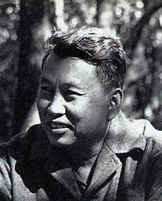
Pol Pot
Pol Pot lived a village life in Preah Savat as a young boy. When he grew older he witnessed the palace life through his cousin, a dancer in royal ballet. He developed an opinion that the King and monarchy was corrupt and simply a puppet of the French colonial power and so he vowed to restore his nation to its former glory (back to the Angkor era). In 1949, he was sent to France to study. In response to his hatred towards imperialism, he developed a political philosophy with the combination of communism and nationalism and joined the communist party in France.
After Vietnam’s fight for independence, Cambodia was also freed from the French colonial rule. However, according to Pol Pot’s opinion and his friends, Cambodia wasn’t fully liberated due to Prince Sihanouk’s reign. They also did not trust the Vietnamese and thought that one day they would betray them. Eventually, Pol Pot developed a double life: he had a job as a history teacher, but at night, he secretly recruited people for the Khmer Rouge.
After Vietnam’s fight for independence, Cambodia was also freed from the French colonial rule. However, according to Pol Pot’s opinion and his friends, Cambodia wasn’t fully liberated due to Prince Sihanouk’s reign. They also did not trust the Vietnamese and thought that one day they would betray them. Eventually, Pol Pot developed a double life: he had a job as a history teacher, but at night, he secretly recruited people for the Khmer Rouge.
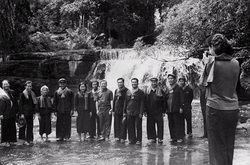
Royal Seal of Approval
In 1962 Pol Pot became a leader of what would become the Khmer Rouge, earning the code name “Brother No. 1.” When Sihanouk started to clear up his enemy, Pol Pot and his group left the city and created a hide-out in the country side. During his time there, he was inspired by village life, as the villagers were obedient which was perfect for revolutionaries. As a result, he started recruiting again.
In the mid 60s, Pot Pot went to China and witnessed Mao’s revolution which valued equality, collectivization. Inspired by Mao’s civilization, he had a game plan: to eliminate all modernization which the ideology that city life is bad and that he should put forth the great movement of farming. Consequently, Sihanouk fell from power due to corruption, losing support and the betrayal of Lon Nol (backed by the Americans).
The Americans involvement in Cambodia (they bombed Cambodia) made more people turn to Khmer Rouge. To add onto that, Pol Pot tricked Prince Sihanouk by forming an alliance agreeing that if Prince Sihanouk supported the Khmer Rouge and helped them win the war against Lon Nol, he would get back his thrown. With Prince Sihanouk as the figurehead, the Khmer Rouge got more support from the people.
On April 17th, 1975 Khmer Rouge overthrew Lon Nol and the Americans. They entered Phnom Penh, providing a sense of hope to Cambodians. However, the city was completely terrorized by the Khmer Rouge as people were forced to go to the countryside—people who resisted were shot. They have provided reasons for emptying the cities and force evacuation: one was that the Americans were going to bomb Phnom Penh; second, their lack of facilities and transportation to bring food to the cities for everyone (according to Ieng Sary); and lastly to break up a spy organization of the enemy (according to Pol Pot). From then on, the terrifying reign of the Khmer Rouge began.
In the mid 60s, Pot Pot went to China and witnessed Mao’s revolution which valued equality, collectivization. Inspired by Mao’s civilization, he had a game plan: to eliminate all modernization which the ideology that city life is bad and that he should put forth the great movement of farming. Consequently, Sihanouk fell from power due to corruption, losing support and the betrayal of Lon Nol (backed by the Americans).
The Americans involvement in Cambodia (they bombed Cambodia) made more people turn to Khmer Rouge. To add onto that, Pol Pot tricked Prince Sihanouk by forming an alliance agreeing that if Prince Sihanouk supported the Khmer Rouge and helped them win the war against Lon Nol, he would get back his thrown. With Prince Sihanouk as the figurehead, the Khmer Rouge got more support from the people.
On April 17th, 1975 Khmer Rouge overthrew Lon Nol and the Americans. They entered Phnom Penh, providing a sense of hope to Cambodians. However, the city was completely terrorized by the Khmer Rouge as people were forced to go to the countryside—people who resisted were shot. They have provided reasons for emptying the cities and force evacuation: one was that the Americans were going to bomb Phnom Penh; second, their lack of facilities and transportation to bring food to the cities for everyone (according to Ieng Sary); and lastly to break up a spy organization of the enemy (according to Pol Pot). From then on, the terrifying reign of the Khmer Rouge began.
Life Under The Khmer Rouge
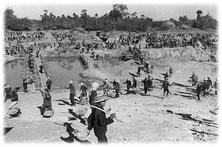
People Working Under the Khmer Rouge
Under the Khmer Rouge, family life was outlawed. People who served for the Lon Nol government and who were educated (doctors, teachers, high-ranking officials) were killed when their backgrounds were found out since the KR feared that these people would form a rebel group against their new government. People were not allowed to criticize or speak ones thought about the Khmer Rouge.
Since the Khmer Rouge thought that city life was corrupt and impure, life of a peasant is the only one that is pure enough for the revolution. People were put in labor camps and worked really hard and given limited rations of food according to how prosperous the farming in the village was. A lot of people died due to starvation/malnutrition, diseases due to lack of health care as well as the unsanitary conditions they lived in, and simply for being accused as a traitor. When Pol Pot became increasingly paranoid, he created a torture centre where they could get out confessions from the so-called “traitors” and were killed, called S-21 (Toul Sleng)—out of the 14,000 prisoners, only 12 survived by the end of the KR.
Since the Khmer Rouge thought that city life was corrupt and impure, life of a peasant is the only one that is pure enough for the revolution. People were put in labor camps and worked really hard and given limited rations of food according to how prosperous the farming in the village was. A lot of people died due to starvation/malnutrition, diseases due to lack of health care as well as the unsanitary conditions they lived in, and simply for being accused as a traitor. When Pol Pot became increasingly paranoid, he created a torture centre where they could get out confessions from the so-called “traitors” and were killed, called S-21 (Toul Sleng)—out of the 14,000 prisoners, only 12 survived by the end of the KR.

Khmer Rouge victim tortured
The social structure in most villages during the KR period comprises three sections. The first-class people: the chief who contains the ultimate power and authority over the whole village, Khmer Rouge cadres, soldiers. These carry out the Angkar laws with the ability to judge, execute, make decisions and report to the Angkar
The second group in this social structure is the base people: they are very powerful like the first class, who lives separately from the lives of the new people and the first class people. They do not get interfered by soldiers and eats, sleeps and lives separately from the new people. They tell the new people what to do and notify the chief with activities and things that went on.
The second group in this social structure is the base people: they are very powerful like the first class, who lives separately from the lives of the new people and the first class people. They do not get interfered by soldiers and eats, sleeps and lives separately from the new people. They tell the new people what to do and notify the chief with activities and things that went on.
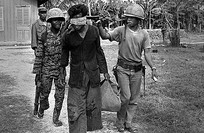
A Khmer Rouge victim
The last in this structure are the new people who have no rights to say anything and must follow orders given by other classes. They are given the hardest work with the longest duration as they were believed to have led a corrupt life and therefore taught to be hardworking people. There are two divisions which were students and people with respectable profession who were ethically corrupted, whereas people who were corrupted by race are those who were either partly or fully Chinese, Vietnamese and other races.
The Fall of the Khmer Rouge
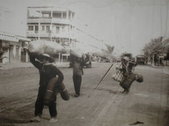
People coming into Phnom Penh
after the KR
Pol Pot’s distrust with the Vietnamese set off the fall of the Khmer Rouge. Since Pol Pot was paranoid about the Vietnamese, he sent troops into Vietnam and slaughtered people. This led to the Vietnamese invasion in Cambodia (January 7th, 1979) which liberated the people from the suppressive reign of the KR. When realizing they have lost the war against the Vietnamese, the KR fled and sought refuge in the jungle, restored a new base along the Thai border and planted landmines. During the 80s, the KR received support from the Americans (they were too proud to acknowledge the good work of the Vietnamese). In 1997, Pol Pot had only 3,000 troops left. Still paranoid, he killed his closest aid. The Khmer Rouge tribunal is still on-going starting since the year of 2009.

